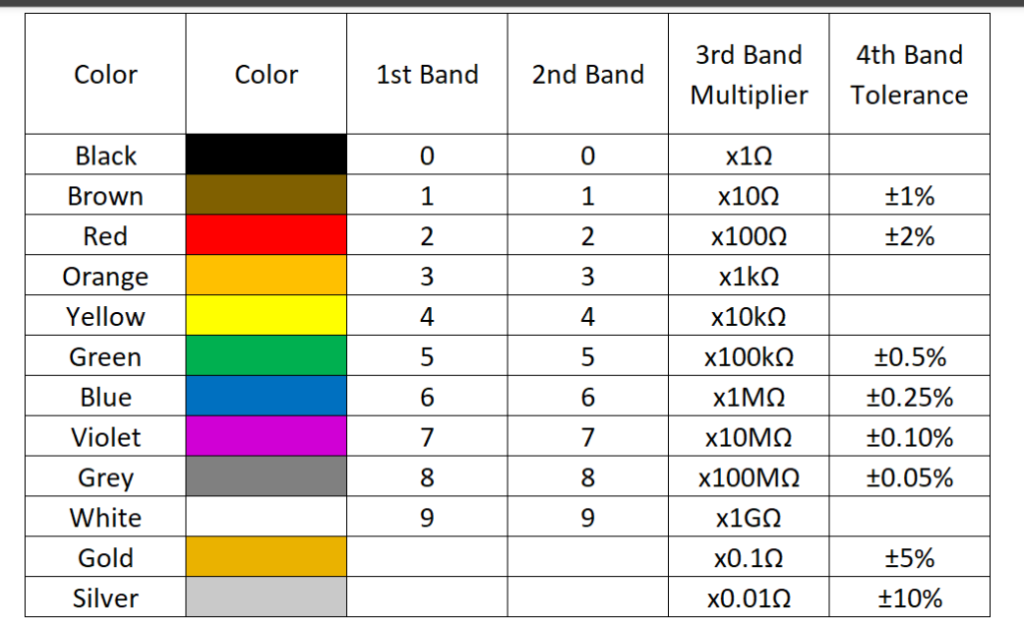
Overview
The Resistor Color Code Decoder Plugin is an interactive tool designed to assist users in decoding the resistance values of resistors based on their color bands, as well as performing reverse lookups to determine the appropriate color bands for a given resistance value. This feature is particularly useful for electronics enthusiasts, students, educators, and professionals working with resistors in circuit design or repair. By providing a user-friendly interface, the plugin simplifies the process of interpreting resistor color codes and enhances the interactivity of a website.
Resistor Color Code Decoder
Reverse Lookup
Core Functionality
[resistor_color_code]
1. Resistor Color Code Decoder
-
Feature Description: Users select the color bands on a virtual resistor, and the plugin calculates and displays the corresponding resistance value, tolerance, and, if applicable, temperature coefficient.
-
Supported Resistor Types:
-
4-Band Resistors: Two digits, one multiplier, one tolerance band.
-
5-Band Resistors: Three digits, one multiplier, one tolerance band.
-
6-Band Resistors: Three digits, one multiplier, one tolerance band, one temperature coefficient band.
-
-
User Interface:
-
Interactive Resistor Graphic: A visual representation of a resistor with clickable or dropdown-selectable color bands.
-
Color Selection: Users choose colors (e.g., black, brown, red, etc.) from a palette or dropdown menu for each band.
-
Real-Time Feedback: As users select colors, the plugin instantly displays:
-
Resistance value (e.g., 4.7 kΩ).
-
Tolerance (e.g., ±5%).
-
Temperature coefficient (for 6-band resistors, e.g., 100 ppm/°C).
-
-
Error Handling: Alerts users if an invalid combination is selected (e.g., no multiplier band or incorrect band sequence).
-
-
Output Format:
-
Resistance value in ohms (Ω), with automatic conversion to kilo-ohms (kΩ) or mega-ohms (MΩ) for readability.
-
Tolerance as a percentage or absolute range (e.g., ±0.47 kΩ for a 4.7 kΩ resistor with ±10% tolerance).
-
Optional: Explains the color code logic (e.g., “Red = 2, Violet = 7, Brown = 10¹, Gold = ±5%”).
-
2. Reverse Lookup (Bonus Feature)
-
Feature Description: Users input a desired resistance value (and optionally tolerance or temperature coefficient), and the plugin suggests the corresponding color band sequence for a 4-, 5-, or 6-band resistor.
-
Input Interface:
-
Text Field: Users enter a resistance value (e.g., “4700” or “4.7k”).
-
Dropdowns: Optional fields for selecting tolerance (e.g., ±1%, ±5%) and temperature coefficient (e.g., 50 ppm/°C).
-
Band Selection: Users specify whether they want a 4-, 5-, or 6-band resistor configuration.
-
-
Output:
-
Displays the color band sequence (e.g., “Yellow, Violet, Red, Gold” for 4.7 kΩ ±5%).
-
Visualizes the color bands on a resistor graphic for clarity.
-
Handles non-standard values by suggesting the closest standard resistor value (e.g., for 472 Ω, suggests 470 Ω with colors “Yellow, Violet, Brown”).
-
-
Error Handling:
-
Validates input to ensure it’s a positive number and within practical resistor value ranges (e.g., 0.1 Ω to 100 MΩ).
-
Warns if no exact color code exists for the entered value and offers the nearest E-series value (e.g., E12, E24 series).
-
Benefits
-
User Engagement: The interactive interface encourages users to experiment with resistor values, increasing time spent on the platform.
-
Educational Value: Simplifies learning the resistor color code system for beginners and serves as a quick reference for professionals.
-
Practical Utility: Saves time for hobbyists and technicians decoding resistors during circuit building or repair.
-
Versatility: The reverse lookup feature appeals to users designing circuits who need to select resistors with specific values.
-
Community Appeal: Encourages sharing of resistor configurations in forums, blogs, or educational settings, fostering community interaction.
Potential Challenges and Solutions
-
User Errors: Incorrect band selections or invalid resistance inputs. Solution: Provide clear instructions, tooltips, and real-time validation with error messages.
-
Non-Standard Values: Users may enter resistance values without exact color codes. Solution: Suggest the closest E-series value and explain the approximation.
-
Accessibility: Color-based interfaces may be challenging for colorblind users. Solution: Add text labels (e.g., “Red” next to the color) and ensure high-contrast visuals.
-
Performance: Minimal computational load, but complex reverse lookups for non-standard values could slow down. Solution: Precompute E-series tables for quick lookups.
Use Cases
-
Educational Platforms: Integrate into electronics courses to teach resistor color coding interactively.
-
Hobbyist Websites: Enhance DIY electronics blogs or forums with a practical tool for resistor identification.
-
E-Commerce: Add to electronics component stores (e.g., DigiKey, Mouser) to help customers verify resistor specifications.
-
Repair Guides: Embed in technician-focused sites to assist with decoding resistors during troubleshooting.
Example Workflow
-
Decoding:
-
User selects a 4-band resistor and chooses colors: Yellow, Violet, Red, Gold.
-
Plugin calculates: (4 * 10 + 7) * 10² ± 5% = 4700 Ω ± 5% = 4.7 kΩ ± 0.235 kΩ.
-
Displays: “4.7 kΩ, ±5% tolerance” with a visual resistor graphic.
-
-
Reverse Lookup:
-
User enters “4.7k” and selects ±5% tolerance for a 4-band resistor.
-
Plugin outputs: “Yellow, Violet, Red, Gold” and shows the resistor graphic.
-
If the user enters “472 Ω,” it suggests “470 Ω (Yellow, Violet, Brown, Gold)” as the closest standard value.
-
Conclusion
The Resistor Color Code Decoder Plugin is a versatile and engaging feature that simplifies the process of decoding resistor values and performing reverse lookups. By offering an intuitive interface, real-time calculations, and support for 4-, 5-, and 6-band resistors, it caters to a wide audience, from students to professionals. Its lightweight implementation, using HTML5, JavaScript, and optional frameworks like React, ensures easy integration into any web platform. The addition of reverse lookup enhances its utility, making it a valuable tool for circuit design and education, ultimately boosting user engagement and platform interactivity.